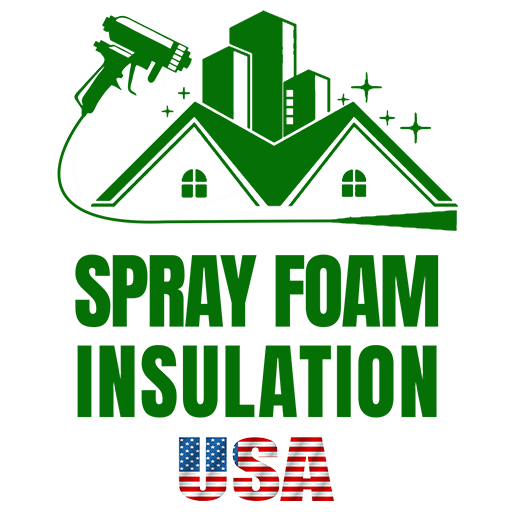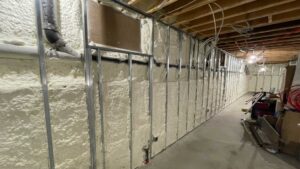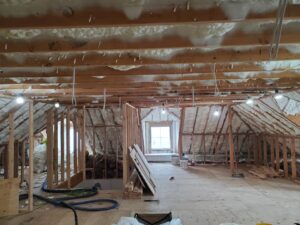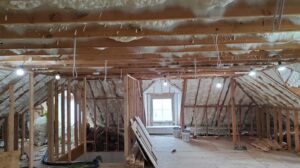Introduction
When you’re looking to insulate your home or business, it’s crucial to choose not just for efficiency and comfort, but also for health. Spray foam insulation has become a favored choice due to its superior air sealing and insulative properties. However, as with any building material involving chemicals, questions about its safety aren’t just common; they’re essential.
At the heart of the concern is whether spray foam insulation is toxic. The simple answer is: Spray foam insulation, when properly installed and cured, is considered safe. That being said, the installation process involves chemicals that can be harmful if exposed to directly before they’ve fully cured.
Spray foam insulation enhances energy efficiency by filling in gaps and cracks, which can lower energy bills and keep your home’s temperature consistent. Yet, for those of us who place a high value on both personal health and environmental sustainability, understanding the potential health risks and ensuring a safe installation process is paramount.

The journey to making an informed decision starts here. Let’s explore what spray foam insulation entails, the nature of its chemical components, and the key considerations to keep in mind to mitigate health risks effectively.
Understanding Spray Foam Insulation
Spray foam insulation is a cutting-edge solution designed to keep your home cozy and energy-efficient. But, what exactly is it? Let’s break it down into simple terms.
Types
There are two main players in spray foam: Open Cell and Closed Cell. Imagine a sponge – that’s pretty much how open cell foam works. It’s softer, airier, and great for soundproofing. On the other hand, closed cell foam is the tough guy. It’s denser, acts as a moisture barrier, and packs a higher insulation punch per inch.
- Open Cell: Light, airy, and sound-dampening.
- Closed Cell: Dense, moisture-resistant, and highly insulating.
Application Process
The magic happens when two chemicals, isocyanate and polyol resin, meet and greet at the tip of a spray gun. This encounter creates an expanding foam that can be sprayed onto various surfaces – from roof tiles to wall cavities. It’s a bit like watching a science experiment in real time. The foam expands, filling up cracks and crevices, creating a seamless barrier that locks in comfort and energy efficiency.
The process requires precision and expertise. Professionals wearing protective gear use specialized equipment to mix and spray the foam. This ensures a uniform application that adheres well to surfaces, providing an effective insulation layer.
Why It Matters
Understanding these basics is crucial. Each type of spray foam has its own set of benefits and potential applications. For instance, if you’re looking to insulate a noisy room, open cell foam could be your best bet. But, if you’re in a damp climate and need to keep moisture at bay, closed cell foam might be the way to go.
Moreover, the application process isn’t a DIY job. It requires skilled professionals who know how to handle the materials safely and efficiently. This ensures that the insulation performs well and minimizes any health risks from improper installation.
Spray foam insulation is a versatile and effective way to enhance your home’s comfort and energy efficiency. Whether you choose open cell, closed cell, or a combination of both, it’s an investment in your home’s future. And with professional installation, you can rest easy knowing that your home is not just insulated, but also safe and sound.
Next up, we’ll dive into the chemical composition of spray foam and discuss potential hazards. This is key to understanding not just how spray foam works, but also how to ensure it’s a safe choice for your home.
Chemical Composition and Potential Hazards
When we talk about what’s inside spray foam insulation, we’re mainly discussing two things: isocyanates and polyol. These are the big players in creating the foam that keeps your home cozy. But, as with anything, it’s not just about what they do, but how they do it, and what else comes along for the ride.
Isocyanates
First up, isocyanates. They’re a group of chemicals used in making all sorts of things, from paints to foam. In spray foam insulation, they react with polyol to create the foam. The catch? They can be pretty irritable to your skin, eyes, and lungs if you’re not careful. The EPA has flagged them for causing asthma and other lung issues. So, they’re not something you want to mess around with.
Polyol
Polyol is the other half of the spray foam duo. It’s generally less worrisome than isocyanates but still deserves attention. It’s a type of alcohol used in making polyurethane, and while it’s less toxic, it’s part of the mix that can react and release other substances during application.
Formaldehyde
Some spray foam insulations release formaldehyde as they cure. Formaldehyde is a known irritant and carcinogen, which means it can cause cancer. It’s not something you want floating around in your home.
Vapors and Aerosols
During the application of spray foam, vapors and aerosols are released. These can contain a mix of chemicals from the foam itself, including isocyanates and others. Breathing these in can lead to respiratory problems, irritation, and sensitization.
Dust
When spray foam is cut or trimmed, it can create dust. This dust can carry the same chemicals found in the foam, which can be harmful if inhaled. It’s another reason why proper safety gear and ventilation are crucial.
Heat-generating Processes
Spray foam reacts and generates heat as it cures. This is usually not a problem, but if too much foam is applied at once, or if it’s near something flammable, it can increase the risk of fire. It’s rare, but it’s a risk worth mentioning.
Fires
Though spray foam is generally resistant to flames, it can still catch fire under the right conditions. Certain chemicals in the foam can fuel a fire once it starts, making it harder to put out.

In summary, while spray foam insulation does an excellent job at insulating your home, it comes with its set of chemical ingredients and potential hazards. Isocyanates and polyol are the main ingredients, with isocyanates posing the most significant health risks due to their irritant and sensitizing properties. Formaldehyde, vapors, aerosols, and dust from the installation process can also pose health risks, while the heat generated during curing and the potential for fires are physical hazards to consider.
It’s not all doom and gloom, though. With proper installation by professionals, good ventilation, and the right safety measures, the benefits of spray foam insulation can be enjoyed safely. Just remember, understanding these components and hazards is the first step towards ensuring your home is not only insulated but also a safe environment for you and your family.
Health Risks Associated with Spray Foam Insulation
When considering the question, “Is spray foam insulation toxic?”, look at the potential health risks. This section covers the key concerns, including respiratory problems, skin and eye irritation, sensitization, asthma, and both immediate and delayed symptoms due to long-term exposure.
Respiratory Problems
Breathing in the chemicals from spray foam insulation, especially before it’s fully cured, can lead to respiratory issues. Workers applying the foam are at the highest risk, but these concerns can also affect homeowners if the space isn’t properly ventilated during and after installation.
Skin and Eye Irritation
Direct contact with uncured spray foam insulation can cause irritation to the skin and eyes. The chemicals in the foam can be harsh, leading to rashes, swelling, and inflammation if skin protection isn’t used. Similarly, without eye protection, the chemicals can cause severe irritation and even temporary vision problems.
Sensitization
Exposure to the isocyanates in spray foam insulation can lead to sensitization. This means that over time, even low levels of exposure can trigger severe allergic reactions. Once sensitized, individuals might experience symptoms from exposure to not just isocyanates but also other everyday substances.
Asthma
One of the more serious health risks is the development of occupational asthma, particularly in workers frequently exposed to isocyanates without proper respiratory protection. This condition can be debilitating and may lead to long-term health issues and a need for ongoing medication.
Long-term Exposure
The effects of long-term exposure to the chemicals in spray foam insulation are not fully understood, but there is concern that it could lead to more serious health issues over time. This includes potential impacts on lung health and the risk of developing chronic conditions.
Immediate Symptoms
Immediately after exposure to the chemicals in spray foam insulation, individuals might experience symptoms like coughing, wheezing, shortness of breath, and fever. These symptoms can occur during or shortly after the installation process, especially if the area isn’t well-ventilated.
Delayed Symptoms
Some health effects might not be apparent immediately. Over time, individuals exposed to spray foam insulation without proper protection may develop more severe health issues, including asthma and sensitization, as mentioned earlier.
The key to safely enjoying the benefits of spray foam insulation lies in understanding these potential health risks and taking steps to mitigate them. This includes ensuring proper installation by professionals, maintaining good ventilation during and after application, and using the right safety equipment. By being informed and cautious, homeowners and workers can minimize the risks associated with spray foam insulation.
Safe Installation and Curing Process
When it comes to installing spray foam insulation, safety is paramount. This part of the guide will walk you through the essentials of a safe installation and curing process. We’ll cover Professional Installation, Ventilation, Curing Time, Protective Equipment, and Re-entry Time.
Professional Installation
The first step in ensuring the safety of spray foam insulation is to have it installed by professionals. Experienced technicians know how to mix and apply the foam correctly, which minimizes the risk of improper installation and potential health hazards. They are trained to handle the chemicals safely and know the best practices for application.
Ventilation
Proper ventilation is crucial during and after the spray foam application. It helps to disperse any harmful vapors and aerosols that are generated during the spraying process. Opening windows, using fans, and ensuring a flow of fresh air can significantly reduce exposure to these chemicals.
Curing Time
Curing time refers to the period it takes for the foam to fully react and harden. During this time, the foam might still release some chemicals. It’s important to know that curing times can vary based on the type of foam, temperature, humidity, and thickness of the application. Generally, manufacturers recommend waiting at least 24 hours before re-entering the area without protective equipment. However, this can vary, so always check with your specific product’s guidelines.
Protective Equipment
Wearing the right protective equipment (PPE) is essential for anyone applying or present during the spray foam installation. This includes respirators, goggles, gloves, and full-body suits. PPE helps protect against inhaling vapors and aerosols, as well as skin and eye contact with the chemicals.
Re-entry Time
Re-entry time is the minimum time you should wait before entering the sprayed area without PPE. As mentioned under curing time, this can vary. However, as a general rule, waiting 24 hours is advisable. For spaces that are not well-ventilated, waiting longer might be necessary. Always follow the manufacturer’s recommendations and consult with the installation professionals.
In conclusion, ensuring the safe installation and curing of spray foam insulation involves several critical steps. Choosing a professional installation team, maintaining proper ventilation, adhering to recommended curing times, using protective equipment, and observing safe re-entry times are all vital. By following these guidelines, you can enjoy the benefits of spray foam insulation while minimizing health risks.
Transitioning into the next section, we’ll explore how to further mitigate health risks associated with spray foam insulation, emphasizing the importance of ongoing ventilation and choosing eco-friendly options.
Mitigating Health Risks
When it comes to insulation, safety is as important as efficiency. For those wondering “is spray foam insulation toxic?”, it’s crucial to address potential health risks. Let’s dive into how we can mitigate these risks effectively.
Proper Ventilation
One of the key steps in ensuring the safety of spray foam insulation is proper ventilation. During and after the application process, ventilating the area helps to clear out any harmful vapors or aerosols that might be present. This means opening windows, using fans, and ensuring a flow of fresh air through the space. Good ventilation is essential not just during installation but also for a period afterward to ensure all residual chemicals are dispersed.
Choosing Eco-friendly Options
Not all spray foam insulations are created equal. Some products are designed with eco-friendliness in mind, minimizing the use of harmful chemicals. When selecting insulation, ask about the product’s chemical composition and look for options that are low in volatile organic compounds (VOCs) and other potentially harmful substances. Choosing eco-friendly spray foam can significantly reduce health risks.
Regular Air Quality Checks
After installing spray foam insulation, it’s wise to keep an eye on indoor air quality. This can be done through regular checks using air quality monitors or by hiring professionals to conduct thorough assessments. If any issues are detected, it’s important to address them promptly to ensure the safety and well-being of all occupants.
Spray Foam Insulation USA
At Spray Foam Insulation USA, we take health risks seriously. Our team is trained in safe installation practices, including how to properly ventilate spaces and advise on the safest products. We prioritize eco-friendly options that not only provide excellent insulation but also ensure the health and safety of our clients. Our commitment to safety means you can trust us to install insulation that’s not just effective but also safe for you and your family.
By focusing on proper ventilation, opting for eco-friendly products, and conducting regular air quality checks, we can significantly mitigate the health risks associated with spray foam insulation. The goal is not just to insulate our homes but to do so in a way that ensures our health and safety. With Spray Foam Insulation USA, you’re choosing a partner who understands this balance and is committed to delivering quality and safety in every project.
Transitioning into the next section, let’s address some of the most frequently asked questions about spray foam insulation, including concerns about safety during and after application, off-gassing duration, and the potential for long-term health issues.
Frequently Asked Questions about Spray Foam Insulation
When considering spray foam insulation for your home or commercial property, it’s natural to have questions about its safety, especially regarding its chemical composition and the installation process. Let’s dive into some of the most commonly asked questions to provide clarity and peace of mind.
Is it safe to stay in the house during and after spray foam insulation application?
Short answer: No, it’s not recommended to stay in the house during and immediately after the application of spray foam insulation.
Why? The installation process involves chemicals that can release volatile organic compounds (VOCs) and other substances into the air. These can be harmful if inhaled, leading to potential respiratory issues, skin irritation, or other health problems. Experts suggest vacating the premises during the application and until the spray foam has fully cured. The typical curing time can vary but generally ranges from 24 to 72 hours, depending on factors like temperature and humidity.
How long does spray foam insulation off-gas?
Short answer: The off-gassing period can last from a few days to a few weeks.
What you need to know: Off-gassing refers to the release of airborne particulates or gases from newly applied spray foam insulation. While the most significant off-gassing occurs within the first 24 hours after application, trace amounts can continue to be released for up to several weeks. The duration of off-gassing can be influenced by the specific type of spray foam used, the conditions of the installation area, and the effectiveness of the home’s ventilation system. Ensuring a well-ventilated space can help expedite the off-gassing process.
Can spray foam insulation cause long-term health issues?
Short answer: Properly installed and cured spray foam insulation is unlikely to cause long-term health issues.
Details to consider: The potential for long-term health effects primarily arises from incorrect installation or inadequate curing of the spray foam insulation. Exposure to uncured spray foam can lead to sensitization, asthma, and other respiratory issues. However, when applied by professionals who follow safety protocols, including proper ventilation and curing times, the risks are significantly minimized. Regular air quality checks post-installation can also help ensure that your living environment remains safe and healthy.
Choosing the right insulation for your property involves weighing the benefits against potential risks. With spray foam insulation, the key to safety lies in professional installation, adherence to curing times, and ensuring good ventilation during and after the process. By addressing these concerns, you can enjoy the energy efficiency and comfort benefits of spray foam insulation with peace of mind.
Conclusion
Health Safety Measures
When it comes to spray foam insulation, being informed is your first line of defense against potential health risks. Here’s the simple truth: once properly installed and cured, spray foam insulation is not toxic and is safe for your home. However, during installation and the curing process, it’s crucial to follow specific health safety measures to avoid any risks.
- Professional Installation: Always choose a licensed professional for the installation. They know how to mix and apply the foam correctly, minimizing exposure to any harmful chemicals.
- Ventilation: Keeping the area well-ventilated during and after installation helps clear any off-gassing chemicals faster.
- Curing Time: Respect the curing time. Re-entering your home too soon can expose you to uncured spray foam’s potential irritants.
- Protective Equipment: Installers should always wear the appropriate gear, including respirators and protective suits, to protect themselves from any harmful effects during the application process.
Choosing the Right Insulation
Choosing the right insulation means balancing your needs for energy efficiency, comfort, and safety. Spray foam insulation offers high R-values, air sealing, and moisture control. But it’s not the only option out there. Consider your home’s specific needs, your budget, and any health concerns you might have. The best choice is one that keeps your home comfortable, lowers energy costs, and supports your family’s health.
Spray Foam Insulation USA
At Spray Foam Insulation USA, we’re committed to providing safe, effective, and eco-friendly insulation solutions. We understand the concerns about “is spray foam insulation toxic” and take every precaution to ensure our installations are safe, following strict health and safety guidelines. Our team of experts is here to guide you through the process, from choosing the right insulation for your home to ensuring a safe and efficient installation.
Ready to enhance your home’s energy efficiency while keeping health and safety in mind? Contact Spray Foam Insulation USA today. Let us help you make an informed decision that benefits your home, your wallet, and the planet.
In conclusion, understanding the health safety measures and choosing the right insulation are crucial steps towards a safer, more comfortable home. With Spray Foam Insulation USA, you can trust that you’re making a choice that’s not only good for your home but also safe for your family.





